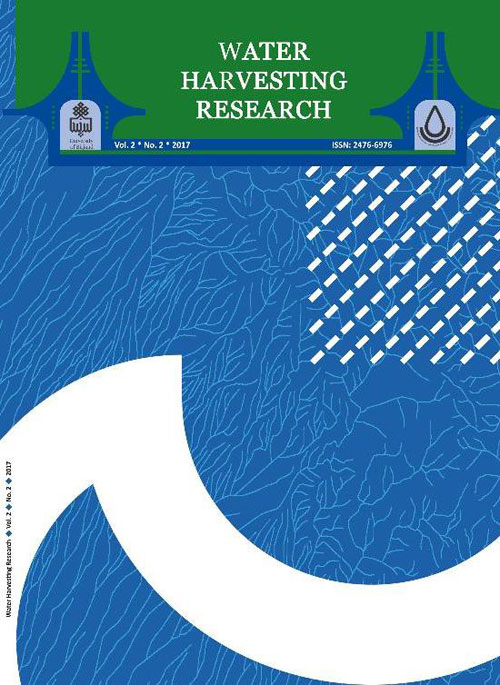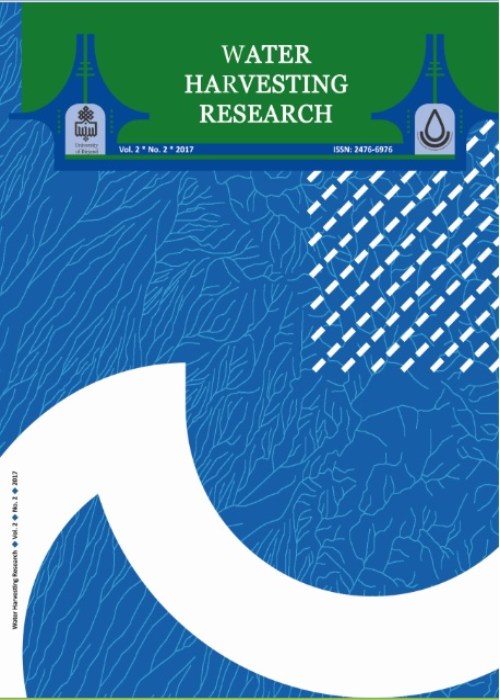فهرست مطالب

Journal of Water Harvesting Research
Volume:3 Issue: 1, Winter and Spring 2018
- تاریخ انتشار: 1396/10/11
- تعداد عناوین: 7
-
Pages 1-14
During recent years, increasing exploitation of groundwater aquifers has caused a substantial and sharp drop in groundwater table in the plains of Iran. Artificial discharge of aquifer using flood spreading in plains is an approach that has been implemented in many parts of the country so far. In this method, by flowing flood into the aquifer, will control flooding and soil conservation. In addition, increasing the volume of the reservoir and preventing a sharp decline in groundwater level do the same work. This research has been used to integrate the AHP / Fuzzy model in order to evaluate suitable land for flood spreading in the Shourdasht watershed in the Ghahavand, Hamadan province. To this end, after the selection of effective indicators in the location of these areas such as slope, permeability, alluvial thickness, transmission capacity, flooding, and hydraulic conductivity, using the analytical hierarchy process (AHP) were weighted and their importance was identified. The fuzzy method was used to normalize the effective measures in the zoning of flood spreading areas. Then, based on the integration of fuzzy layers, a final map of the land suitability for locating the flood spreading areas was determined. The results showed that in the relevant classification it was found that 42.46% accounted for completely unsuitable, 19.27% in the classes with a moderately suitable, and finally 37.78% were in a suitable and completely suitable class.
Keywords: Groundwater Artificial Discharge, AHP, Fuzzy logic, Shourdash -
Pages 15-27
Quantitative changes in groundwater and crises resulting from uncontrolled water extraction have turned water resources management into one of the supply-demand dilemmas in arid regions. The present study evaluated the quantitative situation of water resources in the Ardestan Plain adjoining the Ardestan desert by using the MODFLOW mathematical model. Simulation of groundwater flow in the steady and non-steady states was carried out for a six-year period. Considering the trend of uncontrolled water extraction, results of the simulation also showed that there was a groundwater-level decline in the middle parts of the aquifer and smaller in its western parts. Analysis of the groundwater flow and the water resources balance in watershed basin indicated that in the outlet section of the aquifer the groundwater flow direction was reversed. Given the groundwater-level decline in the aquifer, the groundwater level was higher in the desert section and caused groundwater transfer from the desert to the aquifer. This suggests that the Ardestan aquifer will have environmental problems in its outlet section in addition to problems resulting from lack of water resources management and from the decline in groundwater level. This transport can increase with the continuation of the exploitation trend and also influence a larger part of the aquifer. Consequently, the results of the present research revealed that considering the recent droughts, groundwater extraction must be managed in order to improve the quality and quantity of water in desert aquifers.
Keywords: Aquifer, modeling, Hydraulic gradient, Groundwater flow direction, MODFLOW -
Pages 29-39In this research, monthly rainfall of Shiraz synoptic station from March 1971 to February 2016 was studied using different time series models by ITSM Software. Results showed that the ARMA (1,12) model based on Hannan-Rissanen method was the best model which fitted to the data. Then, to assess the verification and accuracy of the model, the monthly rainfall for 60 months (from March 2011 to February 2016) was forecasted and compared with the observed rainfall values in this period. The determination coefficient of 99.86 percent (R2=0.9986) and positive correlation (P˂0.05) between the observed data and the predicted values by the ARMA (1,12) model illustrates the goodness of this model in prediction. Finally, based on this model, monthly rainfall values were predicted for the next 60 months that the model had not been trained. Results showed the forecasting ability of the chosen model. So, it can conclude that the ARMA (1,12) model is the best-fitted model overall.Keywords: ARMA, Forecasting, Rainfall, Shiraz, Time Series
-
Pages 41-51
The piped water consumption per capita is more than 142 cubic meters per year in Iran that is higher than the consumption per capita of some water-filled European countries such as Belgium and Austria. The use of drinking water for washing dishes, clothes, cars as well as bathing and watering gardens are of the important reasons for piped water high consumption in Iran. However, different lifestyle patterns, water users’ facilities, culture and employment types of the majority, as well as very different climatic conditions in rural areas of the country, have caused different water needs. Therefore, it is necessary to determine different components of household water consumption by doing regional and zonal studies separately throughout the country. For this, three water supply complexes of Ali Abad Looleh, Khoor, and Vahdat were selected according to climatic, economic and social conditions among water supply complexes of South Khorasan province. In this study, 128 common water was randomly selected by considering economic - social and household size conditions. Then, to measure every component of water per capita, including drinking, bathing, washing and watering home green space different counters were inserted at homes. Counters were read daily for a week. Results showed that the average water consumption per capita was 99.9 liters a day for the province rural communities. In addition, the contribution of each component of water per capita, including drinking, bathing, washing and watering home green space were 3.6, 15.7, 63.1 and 17.5 liters a day.
Keywords: Water Consumption Per Capita, Household Sector, Villages -
Pages 53-68Groundwater vulnerability assessment is of crucial importance for land use/cover management. Some methods have been proposed specifically for the karst hydrogeological settings. Among them, COP and PaPRIKa, as two commonly applied recent methods, were adopted for the resource vulnerability assessment of a humid temperate karst region, north of Iran. Comparison of water bacterial content and distribution of vulnerability classes within the catchments for nine springs suggests that PaPRIKa got some higher level of validity, showing more consistency to the catchment properties. Vulnerability class of "very low" was absent in the PaPRIKa map, while the "low", "moderate", "high", and "very high" classes comprised 31.7, 48.7, 12.4, and 7.2 percent of the total region, respectively. Distribution of vulnerability classes within the spring catchments was also surveyed. Importantly, the catchment area of the largest spring, namely Sefidab, which has been supplying drinking water for almost one hundred thousand people in Amlash and Roudsar cities, was predominantly located in the "very high" vulnerability class, enclosing 368 sinkholes. Presence of Escherichia Coli in water emerging from all springs stressed the importance of enforcing strict regulations on the land use planning and conducting required treatments for drinking water supply. Moreover, since infiltration from precipitation and direct-runoff is substantial in the "high", and "very high" vulnerability zones, rainwater and floodwater harvesting may face serious technical challenges there. Hence, intrinsic vulnerability assessment in a karst region can be deserved as a basic criterion for the design of water harvesting systems.Keywords: Vulnerability Mapping, Karst, Design of Water Harvesting Systems, Dorfak
-
Pages 69-79Climate has always been changing during the lifetime of the earth, and has appeared in the form of the ice age, hurricanes, severe and sudden temperature changes, precipitation and other climatic elements, and has dramatically influenced the environment, and in some cases has caused severe changes and even destructions. Some of the most important aspects of climate changes can be found in precipitation types of different regions in the world and especially Guilan, which is influenced by drastic land conversions and greenhouse gases. Also, agriculture division, industrial activities and unnecessary land conversions are thought to have a huge influence on climate change. Climate change is a result of an abnormality of meteorological parameters. Generally, the element of precipitation is somehow included in most theories about climate change. In the present study, climate change and precipitation abnormalities and their impacts on water balance in Guilan Province have been studied. The stations possessing climate change were determined and ranked. The GIS software was used to present the distribution and severity of climate changes in the province as a map. In the next step, the water balance of five stations was estimated using the Thornthwaite method. To do so, the mean data of thirty years, precipitation elements, temperature, and evaporation were used first, and the second time, the estimation was done using the data of the critical year (climate change in the drought trend). The charts related to the mean and critical years were compared. The highest and most severe climate change in drought trend was observed in Lahijan, and therefore this station was introduced as the sample of climate change. These results can be used in planning and identifying the effects of these changes on the environment.in the study station rankings have been determined based on the significance level in drought trend. The intensity of climate change in drought trend is observable in this ranking.Keywords: Climate Change, GIS, Guilan, Water balance
-
Pages 81-91
The recent droughts in Iran made a decline in groundwater table and the migration of villagers to cities was hindered supplying drinking water for the current population. Therefore it should be considered as an important issue. In this regard, it is possible to achieve this goal by constructing underground dams that recently have been suggested to replace by medium and small overland dams. The aim of this study was to compare and investigate the efficiency of multi-index decision-making methods, that is identified as Fuzzy Analytical Hierarchy Process (FAHP) and Fuzzy Analytical Network Process (FANP), to find an initial suitable location for constructing an underground dam in Birjand watershed catchment. The GIS information layers consist of distance to waterways, the geology of the area, the slope of the area, distance to the floodplain, distance to villages, distance to wells, springs and qanats, land use, distance to faults and distance to roads. By using the FAHP and FANP algorithms, weights of information layers were obtained. The results of both methods showed that suitable locations for constructing underground dams are located in the vicinity of low slope waterways. The results of both methods were compared by Chi-Square Test. The result of this test showed that the FAHP and FANP models are significantly different and the FANP method is more accurate.
Keywords: Underground dam, FAHP, FANP, Chi-Square Test


